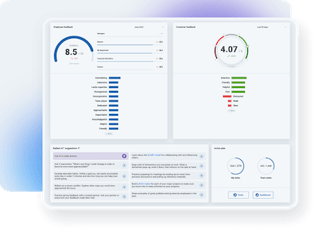
Understanding AI Agents in Employee Experience: What Businesses Need to Know
In 2025 and beyond, AI agents equipped with dynamic reasoning and adaptive learning capabilities may reshape the employee experience (EX) as well. AI agents in employee experience workflows have already led to changes in how some organizations plan and optimize their employee engagement strategies.
According to the latest McKinsey research, generative AI deployment that includes AI agents could theoretically automate 60-70% of global work hours. Companies that have deployed AI agents in customer service found that issue resolution increased 14% per hour on average, despite the handling time for issues dropping by 9%. Similar improvements could potentially occur in employee experience applications, where even small changes can have significant impacts on productivity, engagement, and workforce stability.
As AI agents become more common in HR, many business leaders are wondering exactly what this technology is, and how it might fit into their employee experience strategies. In this article, we'll break down the essentials: what AI agents are, where they currently stand in terms of adoption, how companies are using them today, and key considerations to keep in mind before moving forward.
What are AI Agents in the Context of Employee Experience?
AI agents are autonomous software systems that take action toward predefined goals. Unlike static chatbots, which follow linear rule-based scripts, AI agents can learn from interactions, adapt to new scenarios, prioritize objectives, and respond to problems proactively. One example to consider is an employee seeking information related to paid leave or stress management. A traditional chatbot can clarify the company's paid leave policy when directly asked. However, an AI agent can proactively offer support by recognizing patterns in employee interactions and taking action without explicit prompting. These proactive functions could include:
- Monitoring patterns in employee interactions, such as repeated inquiries about leave policies or stress management resources
- Identifying potential concerns based on these interaction patterns
- Automatically suggesting relevant resources from the company's knowledge base
- Escalating situations by notifying HR personnel to follow up personally when appropriate
These proactive capabilities arise from an AI agent's ability to recognize patterns and respond accordingly without explicit prompting. Chatbots typically respond only to predefined questions. Virtual assistants, while more interactive, primarily schedule meetings and reminders. Both of these technologies are reactive; AI agents in HR are proactive.
Types of AI Agents
The term “AI agent” refers to many subtypes of the technology relevant to the employee experience, including:
Task-based Agents: These AI agents automate repeating tasks to increase speed and efficiency. Examples include time-tracking, ticket-routing, and enrollment duties.
Reflex Agents: These AI agents react immediately to situations according to predetermined rules. For example, if a manager updates a policy, a reflex agent can automatically distribute it to all relevant parties.
Learning Agents: These agents analyze interaction outcomes and historical data from previous actions, improving their responses and strategies over time. For example, an HR chatbot that becomes more accurate at answering common employee questions by learning from previous interactions.
Hybrid Agents: These agents combine traits from multiple AI agent types, such as simultaneous task automation and continuous learning.
AI agents in HR is still in early adoption, where large enterprises are testing the capabilities of these diverse agent groups against success rates for specific functions. Everything from employee screening to worker learning could be impacted by its continued implementation as many industries approach mainstream adoption.
Current Applications of AI Agents in Employee Experience
According to KPMG’s AI Quarterly Pulse Survey for 2024, over half of organizations are currently exploring the use of AI agents, with around 12% having already deployed them. Approximately 37% are piloting these technologies within their HR infrastructure before scaling further.
Companies leading the charge in HR automation tend to be large enterprises with complex HR needs and greater resources to experiment with new systems. Businesses in regulated, tech-oriented industries like accounting and healthcare that are already pursuing digital transformation stand to gain the fastest benefits from agent AI, particularly in information management, process automation, and employee support.
Information Management and Access
AI agents help employees quickly find accurate information without needing direct HR involvement. Instead of manually searching through company documents or submitting help desk tickets, employees can ask an AI agent straightforward questions about policies, benefits, or procedures. The agent instantly retrieves relevant answers from internal knowledge bases, saving time for both employees and HR teams.
Process Automation in HR Functions
AI agents in HR can streamline labor-intensive workflows, such as time-off approvals. The AI agent can automatically compare the employee’s request to company policies and current team schedules to validate or deny it. These agents can also coordinate onboarding tasks by delivering forms, scheduling training sessions, and automating routine administrative processes.
Employee support
AI agents can proactively identify patterns in employee interactions to offer timely support. For instance, if an employee repeatedly searches for stress management resources or frequently asks about leave policies within a short period, the agent can proactively suggest relevant resources or escalate the situation to HR personnel for personal follow-up. This proactive approach helps businesses address potential issues early.
Case Studies of Successful AI Agent Implementation
While the potential benefits of AI agents have driven interest across various sectors, real-world case studies provide valuable insights into how companies are currently using this emerging technology. Organizations have already demonstrated tangible results from implementing AI agents in several key employee experience processes, including recruitment, employee support, learning and development, and workforce planning.
Recruitment
Between 35 and 45% of companies now deploy AI in their hiring and recruitment processes, according to SHRM. Of these employers, over 86% reported that AI saves them time and increases efficiency in the recruitment process, leading to better and faster outcomes. AI agents support recruitment processes by handling repetitive administrative tasks throughout hiring. Companies commonly use AI agents to screen resumes based on predefined criteria, coordinate interview scheduling between candidates and hiring managers, and answer frequent candidate questions about job roles or application status. This reduces manual workloads for recruiters, shortens hiring cycles, and helps ensure a consistent candidate experience.
Employee Support
First-line HR support tools help relieve administrative labor in employee support and information access workflows. AI agents can answer policy, benefits, and payroll questions 24/7, often without escalating to human intervention. Beyond these first-line interactions, broader generative AI technologies are being used by organizations for tasks such as assisting managers with employee feedback (57%) and facilitating long-term employee goal setting (46%).
Learning and Development
AI agents can support Learning and Development by automating routine administrative tasks related to employee training. For example, an AI agent can automatically assign required training modules based on an employee's role or tenure, send reminders about upcoming training deadlines, or answer common employee questions about available learning resources.
According to SHRM, 49% of organizations using generative AI leverage it to create personalized opportunities for employees; another 45% use it to track employee learning more accurately. However, these advanced personalization and tracking functions are typically managed by specialized generative AI tools or dedicated learning management systems rather than autonomous AI agents.
Workforce Scheduling and Administrative Support
AI agents can streamline workforce scheduling and administrative tasks by automating routine processes. For example, companies use AI agents to automatically manage shift scheduling requests, track employee availability, and flag potential scheduling conflicts based on predefined rules. This automation reduces manual effort for HR teams and helps ensure consistent adherence to company policies.
In industries such as retail, hospitality, and healthcare, where managing complex shift schedules is critical, AI agents have helped organizations significantly reduce administrative workloads and improve scheduling accuracy. By automating these routine scheduling tasks, HR teams can focus more on strategic initiatives and employee engagement efforts. According to McKinsey, AI integration in workplaces has the potential to contribute up to $4.4 trillion in productivity growth across various sectors.
These examples illustrate how some organizations are currently using AI agents to address HR challenges through automation. As adoption continues, companies may increasingly integrate AI-driven insights into their workforce planning and learning and development processes.
However, some managers have expressed concerns about potential depersonalization of HR workflows when using AI agents. To address these concerns, organizations implementing this technology typically establish clear escalation protocols and training processes that allow human intervention when needed.
Integrating Advancements with Broader HR Strategies
AI agents are evolving rapidly with advances in machine learning and generative AI. These technologies give agentic AI in HR the ability to handle workflows without human intervention, respond naturally to employee requests, and generate insights from available data. Some modern systems also incorporate multimodal capabilities, integrating visual, voice, and behavioral inputs into their responses.
As organizations consider integrating these emerging technologies into their broader HR strategies, it is important to clearly define how AI agents fit within existing employee experience initiatives. Companies typically implement AI agents alongside other HR tools such as engagement surveys, analytics dashboards, knowledge management systems, and administrative automation. Common objectives for integrating AI agents include:
- Reducing response times for common HR requests
- Increasing employee support satisfaction
- Enhancing accuracy of workforce analytics
- Informing data-based improvement strategies
- Increasing efficiency in hiring, onboarding, and training workflows
While these potential benefits exist, successful integration of AI agents requires careful planning and consideration of organizational challenges such as data quality management, employee acceptance of automation technologies, and clear escalation protocols for human intervention when needed.
Additional Considerations and Challenges for Implementing AI Agents
While AI agents offer potential benefits in employee experience applications, HR professionals surveyed by SHRM in 2024 noted several considerations when deploying and scaling these solutions. Ensuring information consistency between system data and manually updated documents is an important factor. Additionally, clearly defined escalation protocols help AI agents determine when human input or judgment is needed.
Organizations also highlight the importance of transparent communication and effective change management to address employee questions about AI integration. Successfully implementing AI in HR processes requires careful planning around data quality, system hygiene, and proactive protocols. By addressing these considerations upfront, HR leaders can maintain trust in their AI agents, ensure accurate analysis of complex data, and effectively support their employee experience strategies.
Consider these brief steps to successfully deploy AI agents in HR at scale:
- Role-based access control ensures agents can only access relevant data
- End-to-end encryption protects data transfers
- Audit logs keep all AI agent actions traceable
- Frequent audits check for system biases
- Diverse training data sets help employees adjust
- Setting transparent strategies aids adoption
- Provide reskilling opportunities for human agent engagement
Future Trends in AI Agents for Employee Experience: How Your Business Can Prepare
As AI agents continue to gain traction in employee experience applications, business leaders are closely watching how this technology evolves. While currently used primarily to streamline routine HR tasks such as onboarding administration, scheduling, recruitment coordination, and basic employee support, AI agents may expand into new areas as the technology matures.
Looking ahead, organizations will need to thoughtfully evaluate how these emerging technologies align with their broader HR strategies. Rather than viewing AI agents as standalone solutions, forward-thinking businesses will consider how they might complement existing HR processes and enhance overall employee experiences. This means carefully assessing not only potential efficiencies but also implications around data quality, ethical considerations, and maintaining the right balance between automation and human interaction.
To successfully navigate this evolving landscape, business leaders should proactively define clear roles for any new technology within their existing frameworks. Establishing transparent communication strategies, clear escalation protocols for human intervention, and ongoing training programs will help ensure smooth integration. Ultimately, organizations that approach AI agent adoption thoughtfully, focusing on alignment with strategic goals rather than chasing trends, will be best positioned to make informed decisions about their employee experience investments.




